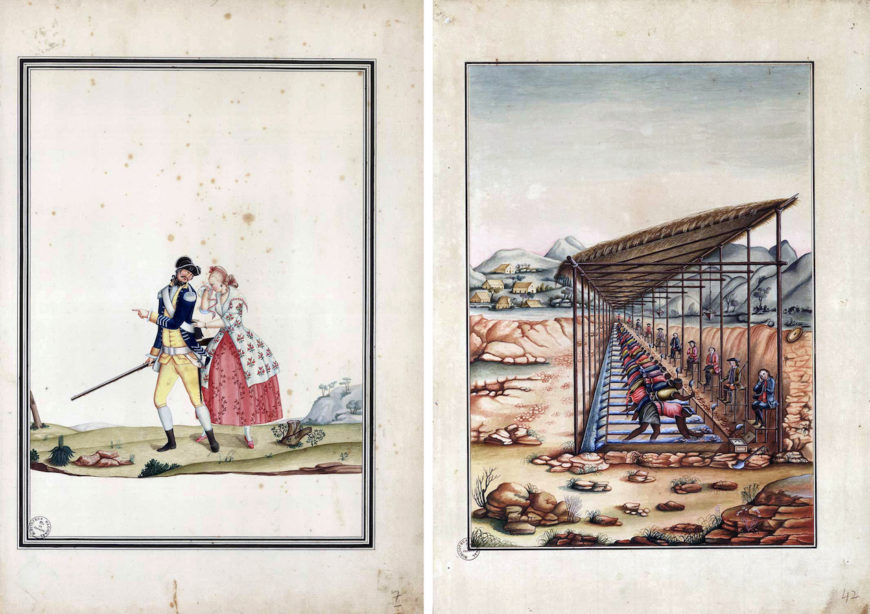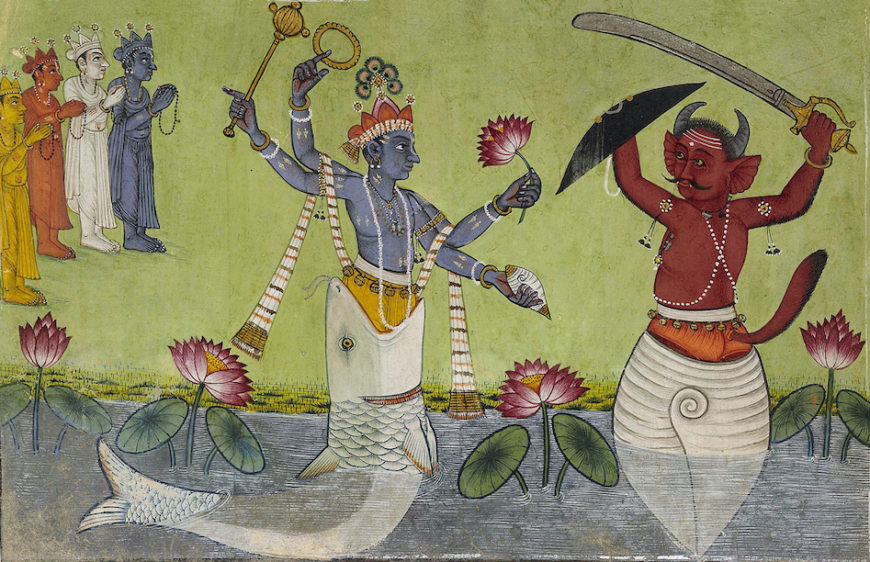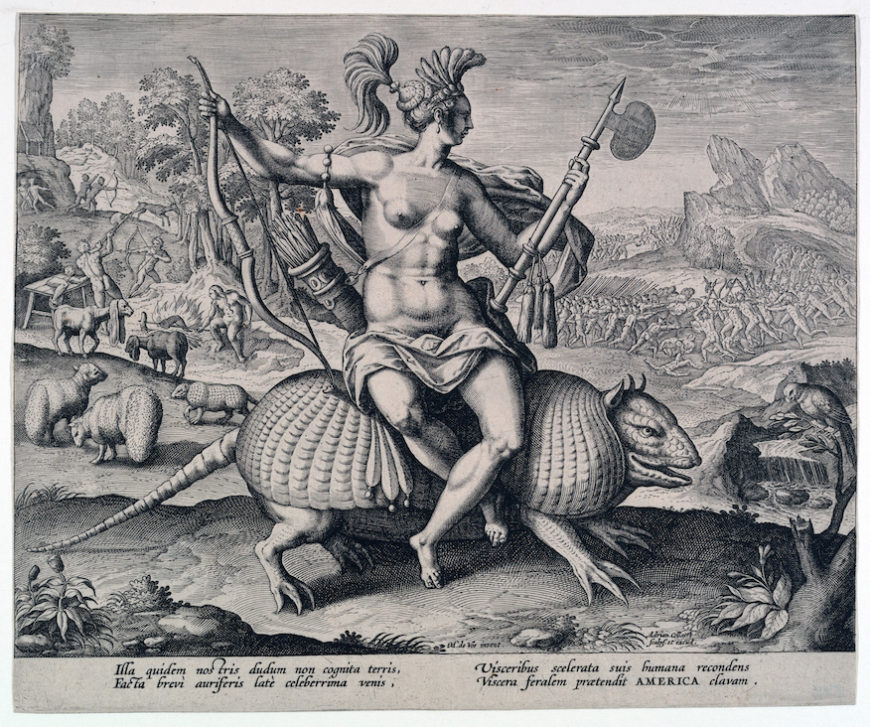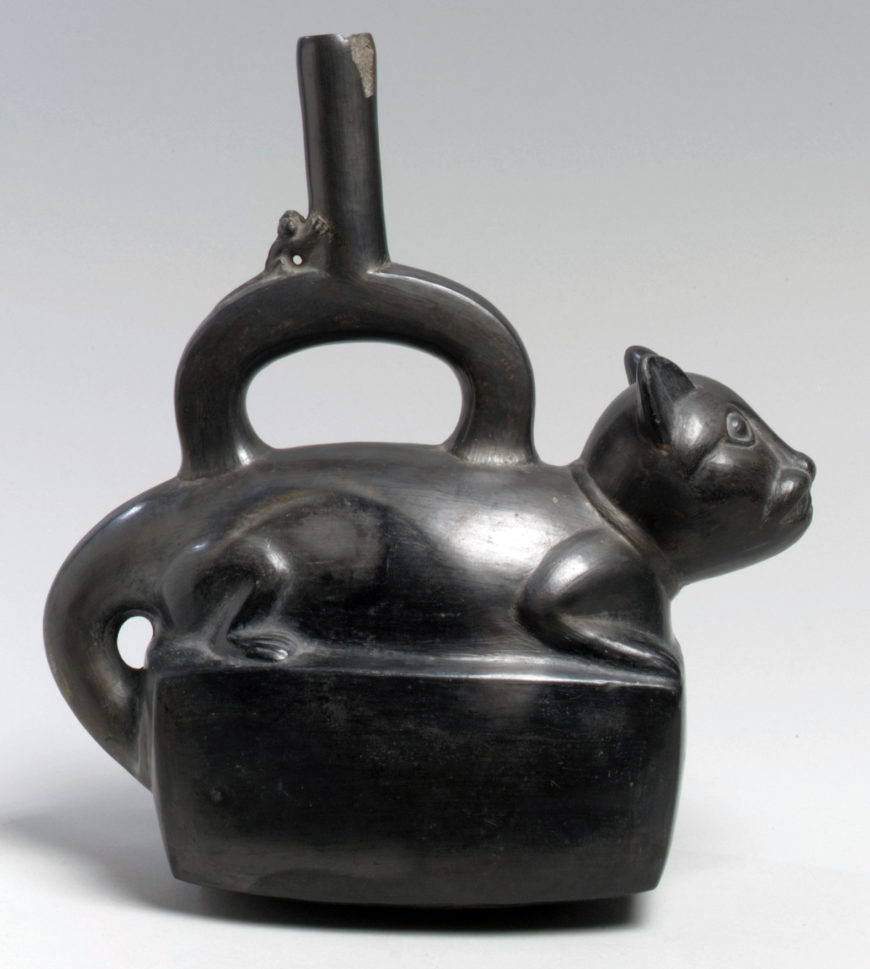
Carlos Julião, left: “A soldier departing from a crying woman”; right: “Surveillance of the diamond mines,” in Noticia Summaria do Gentilismo da Asia…, c. 1780–1800, watercolors (Biblioteca Nacional, Brazil). The manuscript came into the possession of the National Library of Brazil in 1947, but the library did not make any records about the acquisition.
What do images of Hindu deities, Brazilian customs, and Peruvian arts have in common? They are each represented in an eclectic collection of watercolors from the end of the eighteenth century. The artist, known by his Portuguese name Carlos Julião, was Italian by birth, but he worked as an engineer for the Portuguese military. Julião traveled around inspecting fortresses, evaluating security measures, and maintaining Portuguese authority. He traveled on military expeditions to a variety of Portuguese possessions including Brazil, North Africa, India, and China.
Julião’s manuscript contains more than 80 watercolors and consists of three sections:
- “A short account of paganism in Asia”
The paintings of the Hindu deity Vishnu inform viewers about a region of the globe that was part of the Portuguese empire. While other parts of the manuscript are based on eyewitness accounts, this section was copied from another source.
- “Figures of the customs of Whites and Blacks in Rio de Janeiro and Serro do Frio” (Brazil)
The section of the manuscript that depicts scenes from Brazil is quite famous and is frequently used to learn about life in late eighteenth-century Brazil. The images are some of the relatively few depictions of clothing, customs, and religious celebrations in Brazil during this period, many of the paintings are the earliest known representations of certain practices.
- “Peruvian Vases and Textiles”
The final section of the manuscript depicts objects from Peru which was under Spanish control.
In the 18th century, the Enlightenment ideals of scientific discovery inspired many explorers to travel throughout the world documenting the landscapes, animals, plants, and people that they encountered. Julião likely considered himself an Enlightenment scholar and his manuscript a scientific project. Scientific expeditions should not, however, be viewed as neutral or unbiased. Recording and organizing information according to a European worldview was another method of asserting control and establishing European primacy. After all, Julião’s travels were military expeditions that sought to solidify and expand Portuguese power.
Besides the title pages introducing each section, the only other written text in the manuscript is copied from another manuscript on Hindu religion. The Brazilian and Peruvian sections do not include explanatory texts. The title pages do indicate that the writer of the title pages and the painter are the same person, Carlos Julião.
“A short account of paganism in Asia”
The first section, “A short account of paganism in Asia,” is a copy of a text about the Hindu religion of India. The original manuscript that Julião copied has not been found but was probably the work of a Jesuit missionary in India in the 1500s whose goal was to understand Hinduism as a means to convert Indians to Christianity. [1] Julião may have seen the original text while stationed in Goa, India from 1774–79.
Vishnu appears as Matsya in the form of a fish and slays Sankhasura. Carlos Julião, “1st Incarnation Matsya Avatar,” in Noticia Summaria do Gentilismo da Asia…, c. 1780–1800, watercolor (Biblioteca Nacional, Brazil)

Pahari School, Matsya, c. 1760, gouache on paper (© Trustees of the British Museum)
Julião included 10 watercolors that focus on Vishnu and his various incarnations (avatars). His painting of the first incarnation illustrates a story about a conch demon named Sankhasura who steals the vedas (the sacred texts). Vishnu appears as Matsya in the form of a fish and slays Sankhasura. Julião’s depiction of this scene, showing Matsya holding Sankhasura by the hair, differs from typical representations that show the demon within a conch shell (such as in a watercolor from the Pahari School from India). In Julião’s version, Sankhasura is only shown standing in the water on two legs. Although the text repeatedly mentions the conch, Julião does not portray Sankhasura with a conch body. We might ask why? It is unclear why he did not show Sankhasura emerging from a conch shell, but it was perhaps because he was not particularly concerned with iconographic detail. It is also possible that the manuscript he was copying might have omitted the conch body. Unfortunately, this part of the manuscript has not yet been subject to art historical study, but perhaps future research will offer a more concrete explanation.
By the late 18th century, Indian paintings of the incarnations of Vishnu had long been circulating in Europe and had been repeatedly copied, with varying degrees of accuracy, by European printmakers. Hindu artists understood the narrative and its significance differently than did Christian European artists who often emphasized naturalistic bodies and an illusion of three-dimensionality at the expense of narrative details. [2] Julião’s painting exemplifies such European priorities. His watercolor focuses exclusively on the large muscular bodies of Matsya and Sankhasura, whereas Indian representations of the story often include the vedas, shown in a watercolor from the Pahari School from India as four standing figures. As a copy of another text, this section of Julião’s manuscript differs markedly from the other two about Brazil and Peru. Yet, like the next two sections, this part of the manuscript collects and visually represents information about a part of the world that Europeans wished to dominate.
“Figures of the customs of Whites and Blacks in Rio de Janeiro and Serro do Frio”
In the second section of Julião’s manuscript, he focuses on depictions of people in Brazil. The images depict soldiers, white people of various socioeconomic positions, Indigenous people, Black workers and celebrants, and lastly, the grueling working conditions in the diamond mines.
Carlos Julião, “Black Queen Festival,” in Noticia Summaria do Gentilismo da Asia…, c. 1780–1800, watercolor (Biblioteca Nacional, Brazil)
Several pages depict a religious procession that Julião likely witnessed during his years in Brazil. The procession was an elaborate spectacle that filled the streets of cities each year. The watercolor of the “Black Queen Festival” provides evidence for strong cultural connections between celebrations in Central Africa and Brazil. These links are significant as they highlight that many Central Africans who were forcibly brought to Brazil already practiced Catholicism in their homeland, and demonstrate that Central Africans were able to maintain their culture despite enslavement.
The participants are members of the brotherhood of Our Lady of the Rosary, an organization that allowed free and enslaved Afro-Brazilians to support their community and to join together in Christian worship. The procession includes both a king and a queen (people that the rosary brotherhood elected to serve in those roles during the celebrations). Julião paints the queen with attendants, musicians, and dancers who display a mixture of Central African and European clothing and status symbols. The queen and the musicians wear European-style clothing with African additions—the queen’s red cape and the fabric wrapped around the musicians’ hips. The attendants holding the cape and umbrella—an important symbol of status in Central Africa—wear wrap skirts and sashes over their bare chests. The feathers on the figures’ heads and the musical instruments are also Central African in origin.
Over a span of three hundred years, enslavers forcibly transported almost five million Africans to Brazil. These Africans and their descendants adapted the cultures that they brought from various regions of Africa to circumstances in Brazil. The painted procession relates to a ritual called sangamento from the Kingdom of Kongo in Central Africa. The Kongo king converted to Christianity in 1491, and his son introduced new rituals that celebrated the adoption of Christianity. Since positive relationships with Europeans—through trade and shared Christian belief—strengthened political power in the Kongo kingdom, the ritual incorporated Christian elements and European symbols of status.
Carlos Julião, “Two Indigenous Brazilians,” in Noticia Summaria do Gentilismo da Asia…, c. 1780–1800, watercolor (Biblioteca Nacional, Brazil)

Adriaen Collaert, “Allegory of America,” from the Four Continents, 1580–1600, engraving (The Metropolitan Museum of Art)
In contrast to paintings of events that Julião witnessed, all of his depictions of Indigenous Brazilians rely on longstanding stereotypes and tropes. In one example, an Indigenous man and woman stand bare-chested in a landscape, wearing only feathered skirts. Although some Indigenous groups wore feather headdresses, the feather skirts are a misleading addition that Europeans had incorrectly associated with native Brazilians since the sixteenth century. The man holds a bow and arrow, and the monkey sitting on the woman’s shoulder is a mico, a species that Julião likely saw frequently in Brazil; the armadillo in the lower left corner is also native to Brazil.
These animals and tools for hunting are appropriate to the region, but their inclusion in the painting is related to exoticized European imagery of the Americas rather than Julião’s experiences with actual Indigenous people. For instance, the bow and arrows and armadillo feature prominently in Adriaen Collaert’s print called the “Allegory of America.” Like the watercolor, the print emphasizes Native American nudity, weaponry, and connections to the landscape and animals. The print also includes scenes of warfare and cannibalism, further reinforcing a European view of Indigenous people as dangerous and uncivilized. Julião’s depictions of Brazilians combine a desire to document for educational purposes with a reliance on existing narratives about foreign places and peoples. These narratives served to justify European domination of these peoples.
Carlos Julião, “Monkey Vessel,” in Noticia Summaria do Gentilismo da Asia…, c. 1780–1800, watercolor (Biblioteca Nacional, Brazil)
“Peruvian Vases and Textiles”

Chimú, Feline Bottle, 12th–15th century, ceramic (The Metropolitan Museum of Art)
The last section of Julião’s manuscript represents textiles and ceramics from the Andes, an area that he never visited. [3] Julião writes that the objects had been rescued from a Spanish shipwreck off the coast of Portugal. The ceramics and textiles are carefully delineated with geometric precision against a blank background, suggesting that they are meant to serve as scientific documents rather than as objects within a still-life composition.
One of the ceramics that he portrayed is a black stirrup-spout vessel in the shape of a cube, with a seated monkey atop the cube and an even smaller monkey holding onto the spout. The painting closely resembles the smoothly finished and precisely sculpted vessels produced by the Chimú in Peru before Spanish forces arrived in the region. Even though Julião notes that the wrecked ship that carried these objects was laden with silver, he portrays items that inform viewers about Andean cultures instead of the commercially valuable silver. This further suggests that his intent in creating the watercolor images was to learn about and document different cultures throughout the world. This is also supported by the fact that, unlike the other sections of the manuscript, here he records cultural objects from a region that he had not visited and that was under Spanish rather than Portuguese control. His intention with the manuscript as a whole appears to have been to compile as much information as he could gather about cultures that were foreign to him.
An outsider’s perspective
While the manuscript can be seen as the project of an Enlightenment scholar, the imperial context in which Julião lived is also important. As part of the military, Julião worked to enforce Portuguese control throughout the globe. This control was under pressure from locals who sought autonomy and from other European powers who wanted to colonize those regions. Julião was not only gathering information but was also exerting military power over the cultures and places that he observed. The watercolors present Hindu religion, Brazilian customs, and Andean artworks as seen through the eyes of a European colonizer, who may have had little knowledge of the cultures and peoples that he portrayed. The images are useful records of shipwrecked items, Brazilian clothing, and other customs; however, they need to be viewed as constructed images rather than as objective documents.
Notes:
[1]Three other Portuguese artists also produced copies of the manuscript with illustrations that vary in number, composition, subject matter, and style. Two of the other copies can be seen here: Notiçia Summaria do Gentilismo da Azia, (il 228) 18th c., Biblioteca Nacional de Portugal and Noticia Summaria do Gentilismo da Azia, (cod. 607) after 1759, Biblioteca Nacional de Portugal.
[2] Robert del Bontá, “Engraving India in 17th- and 18th-century Europe,” Art in Print, volume 4, number 4 (2014), pp. 20–25.
[3] The reverse side of some of these images contain loose sketches of landscapes and figures. Scholars do not know how these unfinished sketches fit in with the rest of the manuscript and they may be the result of Julião reusing paper.
Additional resources
Downloadable pdf of Carlos Julião’s manuscript
Cécile Fromont, “Dancing for the King of Congo from Early Modern Central Africa to Slavery-Era Brazil,” Colonial Latin American Review, volume 22, number 2 (2013), pp. 184–208.
Cécile Fromont, editor, Afro-Catholic Festivals in the Americas: Performance, Representation, and the Making of Black Atlantic Tradition (University Park: Pennsylvania State University Press, 2019).
Silvia Hunold Lara, “Customs and Costumes: Carlos Julião and the Image of Black Slaves in Late Eighteenth-Century Brazil,” Slavery & Abolition: A Journal of Slave and Post-Slave Studies, volume 23, number 2 (2002), pp. 123–46.
Maria Manuela Tenreiro, “Military Encounters in the Eighteenth Century: Carlos Julião and Racial Representations in the Portuguese Empire,” Portuguese Studies, volume 23, number 1 (2007), pp. 7–35.

